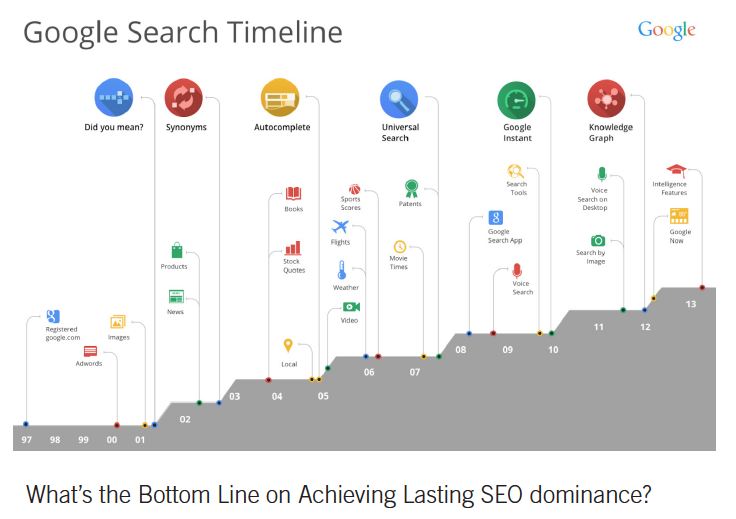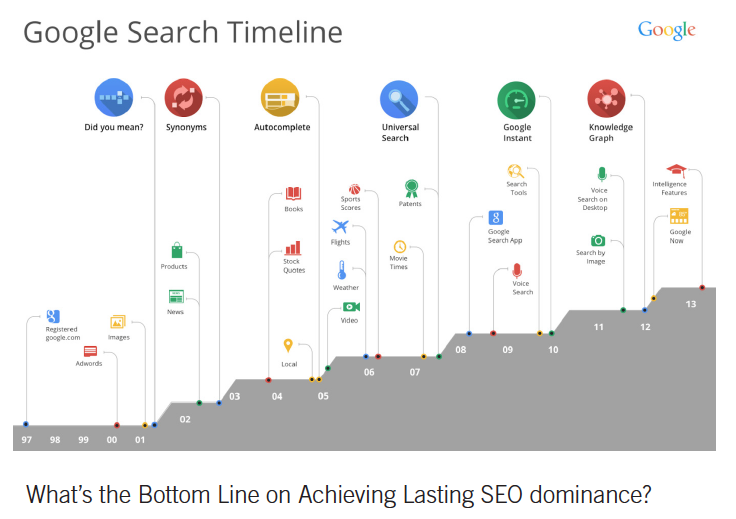The Bottom line on Lasting SEO Success
WANT SEO SUCCESS? CREATE WEBSITES AND CONTENT FOR USERS, NOT FOR GOOGLE
Way back in the “olden days” (and by that, I mean six or seven years ago in the supersonic-paced cyber world), most thought they could find easy, cute ways to “game” the search engines and gain an awareness advantage for their websites. You know, jamming the content, HTML title tags and meta tags full of the same keywords over and over, which ended up developing low-quality, spammy links.
Occasionally it actually worked and some would crow about their SEO expertise, but usually it didn’t—to the extent that this sort of crude “gaming SEO” would actually lower the rank of a website. And then, of course, those who gamed SEO would fall back on “Oh, Google must have changed their algorithm again,” even though they really had no clear idea about what had actually happened. Some black-hat SEO “consultants” today are still trying newer versions of the old, cute tricks, pitching the less-knowledgeable website owner, who thinks his or her website is pretty hot, with “we know how to go in and get you instant rank increases. You don’t really need to ‘change’ your website.” In other words, many “experts” still feel they don’t actually have to do things the right way so long as they make it appear like they’re doing it the right way.
Over time, integrated marketing and advertising agencies whose holistic focus is white-hat marketing tactics, have learned that there are no easy ways to artificially influence search engine rankings. Not to mention that the rapid genesis, manifestation, and growth of social media and mobile devices have added several more layers of complexity to the challenge. Also, Google, et al., have learned how to improve and expand their highly complex algorithms (200+ ranking signals) to arrive at results that represent more of what users want and less of what users don’t want. In case you haven’t heard, Google can afford to hire a team of very smart folks. Just take a look at this Google timeline to see how far they’ve come and how sophisticated they have become—and how strategic integrated marketing agencies keep performing well in the rapidly changing search engine environment:

WHAT’S THE BOTTOM LINE ON ACHIEVING LASTING SEO DOMINANCE?
So, if we used to think that just making a website “look right” would drive it to achieve impressive SEO results and we’ve learned that approach is not working at all today, what is the right SEO approach in today’s new “Pirate 2.0, Penguin 3.0, Pigeon” universe of search engines?
To find that answer we need to first look at the impetus behind every search engine. What business are the search engines in? What is their most important goal? While we will likely never know the ins-and-outs of their algorithms, if we can foresee what they are trying to accomplish as a business, we can know what they are trying to make happen with their complex, ever-evolving search algorithms. When we discover the goals of their algorithms, digital marketing agencies can align SEO efforts to that purpose and be confident they will achieve better search rankings for their clients.
So, what business are the search engines in? One word: advertising. That’s the bottom line—they want to sell advertising and increase sales of advertising and their rates for that advertising. Just as you want to sell more widgets in your business and I want to generate more leads for you to help my business, we make every effort to align everything in our business to accomplish our goals more effectively, the search engines make every effort to ensure they sell increasing amounts of advertising.
How do they accomplish that? By attracting more and more users. The more eyeballs on their results, the more attractive their search platform is to advertisers and the more they can charge for it.
How do they attract more users? (Attention—the next sentence is the key to successful SEO). Search engines attract more users by providing the most relevant possible search results and best possible user experience. The more spot-on the results provided by a search engine are to the true intention of my query, and the faster the results appear, and the easier they are to find on the destination page, the more likely I am to use that search engine regularly.
Google’s last three algorithm updates, Pirate 2.0, Penguin 3.0, and Pigeon, have completely redefined the user search experience and you can be sure that every other search engine is watching and following the leader as closely as they can. Google is the leader for a reason—they made great efforts and have taken strides toward ensuring that users get the very most relevant results for their searches in the shortest amount of time. By Q4 2014, Google had amassed 14% of all expedited patents issued by the USPTO’s new fast-track program, earning nearly 10 patents per day. By placing the results that would appear to best match the intention of the users search at the top of their results, Google provides the most relevant answers to the user’s query.
The Panda update used artificial intelligence to push black-hat, spammy websites off the first page of results and began to focus page rankings on usability, content, quality design and better user experience on the page. The purpose of the Penguin update was to ensure that websites addressed all of the elements of Google’s Webmaster Guidelines (support.google.com/webmasters/answer/35769?hl=en) and utilized only legitimate links to improve rankings.
In September, 2013 Google announced Hummingbird. This nearly complete re-do of the algorithm was intended to produce more relevant results, based on the intention of the user’s query, by allowing more “conversational” search entries. In effect, Hummingbird allowed users to make “long-tailed” searches which it can respond to based on the entire query and not just a keyword-by-keyword analysis.
So we can logically form a hypothesis that every search engine’s algorithm rewards solid, informative, 3 FabCom White Paper accurate website content that answers the user’s query, is supported by an architecture that is clear and informational (a function of the design of the website and lastly, loads quickly to the search engine’s results page (a function of the coding of the website). There we have it: Success in SEO results from a website’s quality content, quality design and quality programming. Did you notice “cute tricks” are not a part of the hypothesis? Like most businesses, search engines realize that providing the best possible product, in this case, fast, relevant results, is the best way to attract users and increase income. “Makes sense,” you’re thinking, but how about a little verification that we’ve discovered the “secret” to successful SEO.
Matt Cutts, 14-year Google veteran, who leads the Webspam team at Google and works with the search quality team, is also one of the co-inventors, according to a Google patent related to search engines and web spam:
“Our advice has always been the same—great user experience. Make sure people link to you because you’ve got a fantastic site, come up with something compelling. Don’t go to “black hat” forums, try to spam, try hi-jinks or tricks because those sorts of technique are going to be less and less likely to work going forward. We will be doing everything we can to return the best, high quality pages and search results to users. And if you are the one generating those pages we would like to return your deliverables in our results.
But we also do not want to encourage spam, so we are continuing to take action on it and continuing to enforce those polices strongly. Before you sign up with any SEO firm, ask for references do some research and ask them to tell you exactly what they are going to do. Keep doing white hat, wonderful, original, compelling things on your site and then we’ll return the best set of search results to users.”
IT’S HARD WORK, BUT AS A TOP PHOENIX MARKETING AND ADVERTISING AGENCY WE DO IT.
Because it’s right and it achieves our clients’ goals, SEO is becoming less about lazy stuffing, programming tricks and spammy link-building, and more about the quality of design, user experience and content. Google’s recent massive re-dos of their algorithm, Pirate 2.0, Penguin 3.0, and Pigeon have emphasized and accelerated that trend. At FabCom, this has given us an opportunity to take advantage of these updated algorithms by continuing to help our clients optimize their websites with a better user experience and compelling content, which will also help them achieve significant search result competitive advantages. Don’t waste your time or money hiring so-called “SEO experts” who want to “help” you by trying to trick search engines. Good content and developing an authoritative online and offline presence is the only way you will ever reap the tremendous value of being represented in top search results.
As a top integrated marketing agency in Phoenix, we regularly get calls from frantic business owners that made poor decisions and have been penalized by Google or one of the other search engines. Their stories are pretty consistent—they engaged an SEO company or consultant to increase the rank of their site and the “experts” used “tricks of the trade” to goose the page rankings, which actually ended up dropping the rankings. Now, they’ve lost a significant amount of revenue because of the decreased search rankings. By the time we talk to them they are at the end of their rope. Unfortunately, we have to tell them the truth. Digging their way out of the hole is usually not easy, it’s not inexpensive and it takes honest effort.
At FabCom, our long-term, proven success in generating outstanding search engine rankings for the online brands is based on a solid foundation of knowing what 4 FabCom White Paper the search engines want and giving it to them—quality content, design and user-centric architecture. For us, it means never trying to “game” a search engine and doing the right things all the time. If we get the opportunity early on, we can consistently save our clients millions of dollars over the long run, in addition to moving their online presence or website to the top of organic search results. And that means tens of thousands of dollars in increased revenue.
Our proprietary methods of audience segmentation and brand mapping—based on the science of Neuromarketology as well as our quantitative user eye tracking methodology actually allows us to better “know” the search intentions of users involved in the concepts, topics and brands of our clients so that we can better craft quality content that answers their queries more effectively and gets to the top of organic search rankings. But that’s a topic for another post. Stay tuned.
Yes, an integrated approach to SEO and online brand optimization is more difficult, requires more effort and better thinking, but it’s the right way – it works for more than a week, a month or a year. It works for the long term.











